Ramiro Velázquez, Omar Bazán, and Claudia Alonso
Mechatronics and Control Systems Lab, Universidad Panamericana, Aguascalientes, Mexico
INTRODUCTION
This paper evaluates the potentials of tactile-foot stimulation to assist the blind in key tasks such as mobility and situation awareness. A wearable electronic tactile display for the foot is used to stimulate the plantar surface with vibrations containing spatial and temporal information. Two experiments were conducted with 20 healthy sighted voluntary subjects: the first one involves recognition of cardinal directions useful for mobility while the second addresses tactile language learning and tactile memory useful for describing situations. Results obtained demonstrate initial feasibility of this approach.
BACKGROUND
Touch has been exploited in mobility assistive devices for the blind since the late 70s when the Mowat sensor, a hand-held ultrasonic device, displayed the distance to an object by means of tactile vibrations (Pressey, 1977). The list of electronic travel aids (ETAs) providing tactile feedback over these decades is long. The MiniGuide (GDP-Research, 2011) and the Ultra Cane (Sound Foresight Ltd., 2011) are just two representative examples.
ETAs providing tactile feedback have gained popularity over those providing acoustic feedback because they do not interfere with the blind person’s ability to pick up environmental cues through hearing. Moreover, tactile feedback does not cause distraction and does not saturate the major sense for the blind with musical tones.
Most of the ETAs that exploit tactile stimulation are destined to the fingertips and palms. They are usually used in conjunction with the primary aids (white cane and guide dog) (Kay, 1984). As they require constant hand interaction, they quickly cause bodily fatigue and user rejection.
We have developed a tactile display for the foot that allows hands-free interaction and that is worn rather than carried by the user. This prototype consists of four actuators embedded in a foam shoe-insole that provide vibrotactile stimulation to the foot sole. This inexpensive device can be further inserted into a shoe making it an inconspicuous visually unnoticeable assistive device, which is an essential need for blind people.
This paper overviews the prototype developed and evaluates the capabilities of tactile-foot stimulation among healthy sighted. Results strongly suggest the applicability of this approach for the blind, especially in tasks such as mobility and situation awareness.
SYSTEM OVERVIEW
 Figure 1: Vibrotactile display for the left foot. d
Figure 1: Vibrotactile display for the left foot. dThe prototype shown in fig. 1 is a wearable electronic tactile display that stimulates the mechanoreceptors in the foot sole with vibrations. This device consists of four vibrating motors all integrated in a foam shoe-insole. Motors are arranged in a diamond-like shape with 35 mm interspacing. They provide axial forces up to 13 mN and vibrating frequencies between 10-55 Hz. Each motor is independently controlled with a specific vibrating frequency command.
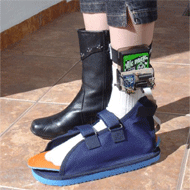
Figure 2: Fully wearable device with on-board battery and RF receiver. d
This device is completely wearable. Fig. 2 illustrates how it is worn by a user. Note that battery, RF (radio-frequency) module, and control circuitry are all embedded in an electronic module that the user carries comfortably attached to the ankle. Experimental tests reveal a 6 h continuous operation of the device and a 100 m communication distance range with a computer (Velazquez, 2011).
EVALUATION
Perceptual experiments were carried out to evaluate the prototype’s ability to transmit tactile information to the user and its pertinence as an assistive device. Two experiments were conducted: cardinal direction recognition and language learning.
A total of 20 subjects (14 men and 6 women) participated voluntarily in the experiments. All gave their consent in agreement with the university ethics guidelines. Subjects were healthy sighted undergraduate students at Panamericana University. No special criteria were used to select them but availability. Their ages ranged from 19 to 23 years old with an average age of 20.4. None of them reported previous experience using tactile displays. All but one were right-handed.
During the experiments, the subjects were wearing the tactile display on the left foot. For hygiene, all subjects were requested to use socks. Before each session, they were totally naive about all aspects of the test. A short familiarization time was granted prior to the tests.
For statistical analysis, subjects were randomly divided into two groups of 10. The χ2 distribution was used to evaluate difference in proportions across samples of a same group while the z-test to give a confidence interval for the true difference in proportions between groups. The level of significance to reject the null hypothesis (α) was set to 0.05 in all cases.
Cardinal direction recognition
The purpose of this test was to determine whether the subjects could recognize directional information represented by the cardinal points.
Method:

Figure 3: Schedule of activation of the motors for the cardinal direction recognition task (example for South). d
Each one of the four contact pins of the tactile display was set to represent a cardinal point. A cardinal direction is encoded in five sequences (t1-t5) as follows: three consecutive short vibrations in the corresponding contact pin, then a short vibration in the opposite contact pin, and again a short vibration in the correct contact pin. Fig. 3 shows for example, the codification for South. Note that the contact pin S vibrates three times, then N once, and again S.
A set of 14 directions was presented to the subjects in one trial. All 20 subjects were asked to report the direction perceived with no time restriction.
Results:
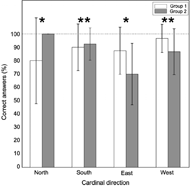
Figure 4: Performance of the 20 subjects at identifying cardinal directions (*p<0.05,
**p>0.05). The standard error is shown as an error bar. d
Results obtained are presented in fig. 4. For group 1, the average recognition rates were 80%, 90%, 87.5%, and 96.6% for N, S, E, and W, respectively. For group 2, these were 100%, 92.5%, 70%, and 86.6%, respectively. Note an overall good performance.
Subjects in group 1 exhibited a uniform performance across the test (χ2=4.24, p=0.23). However subjects in group 2 did not (χ2=15.17, p=0.0016). For this group, East and West were significantly more difficult to identify than North and South. There was no statistically significant difference in the recognition rates between groups for South and West (p>0.05). Not so for North and East (p<0.05).
Language learning and tactile memory
Situation awareness is another major problem for the blind. It involves being aware of what is happening in the vicinity to take pertinent actions. More sophisticated vibrating patterns could be used for providing situation awareness. However, users would be required to learn a new tactile language and to remember it in order to understand the situation the device is trying to communicate.
In this context, we propose a test dealing with tactile language learning and memory. Its purpose is to evaluate whether the subjects could quickly learn tactile words and retain them in memory.
Method:
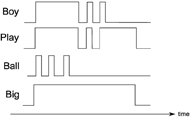 Figure 5: The four tactile words. d
Figure 5: The four tactile words. dFour tactile words were chosen for this test: boy, play, ball, and big. The vibrotactile patterns in fig. 5 were arbitrarily chosen to represent these words. For example, “boy” in tactile language is represented by a long vibration followed by two short ones while “ball” by three consecutive short vibrations.
Subjects were asked to match what they felt tactually with one of these words. Before the test, all four tactile words were displayed to the subjects so that they could make a mental representation of them. Upon request, they could have the tactile word refreshed on the display. When ready, the tester made a 1 min small talk on purpose to distract their mind from the test. The test consisted of a single trial. Each word was randomly displayed twice. Subjects had no time restriction to provide their answers and they were allowed to modify them if they felt they had made a mistake.
Results:
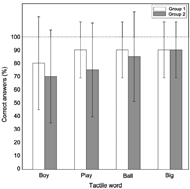
Figure 6: Performance of the 20 subjects at learning and memorizing tactile words (p>0.05). The standard error is shown as an error bar. d
Fig. 6 shows the results obtained. For group 1 the average recognition rates were 80%, 90%, 90%, and 90% for boy, play, ball, and big, respectively. For group 2, these were 70%, 75%, 85%, and 90%, respectively. Recognition rates suggest that the tactile words were easy to learn and to remember.
Contrary to the previous test, subjects in both groups exhibited a uniform performance across the test (group 1: χ2=1.37, p=0.71, group 2: χ2=3.12, p=0.37). Furthermore, there was no statistically significant difference in the performances of the two groups (p>0.05).
We decided to go further with this experiment by combining tactile words to construct sentences. This test would require a higher level of concentration and could be useful for describing more complicated situations.
Method:
The tactile words were combined in four sentences: “big-boy”, “boy-play”, “big- ball”, and “play-ball”. Sentences were displayed as in verbal communication: one word first, then a short pause, then the second word.
Subjects were asked to feel the entire sentence before reporting the words perceived. They were not aware about the sentences so they could report any possible combination. The test consisted of a single trial. Each sentence was randomly displayed twice. Subjects had no time restriction to provide their answers and they could have the tactile sentence refreshed on the display upon request.
Results:
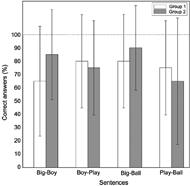
Figure 7: Performance of the 20 subjects at recognizing tactile sentences (p>0.05). The standard error is shown as an error bar. d
Fig. 7 shows the results obtained. For group 1, the average recognition rates were 65%, 80%, 80%, and 75% for big-boy, boy- play, big-ball, and play-ball, respectively. For group 2, these were 85%, 75%, 90%, and 65%, respectively. Recognition rates are undoubtedly encouraging.
As in the previous test, subjects in both groups exhibited a uniform performance across the test (group 1: χ2=1.6,p=0.65, group 2: χ2=4.4, p=0.22). Again, there was no statistically significant difference in the performances of the two groups (p>0.05).
DISCUSSION
Results obtained from these tests seem very promising for tactile-foot stimulation.
Success rates in cardinal direction recognition strongly suggest the possibility of guiding blind people through environments. We found that vibrating patterns indicating directional information are easier to understand if the opposite direction is also displayed to indicate a direction. This provides a reliable reference to identify points of vibration when users are unable to locate them precisely throughout the foot sole.
Patterns abstractly representing verbal language can also be understood, quickly learned, and retained in memory. Furthermore, sentences involving two tactile words can also be constructed and recognized, which broadens the possibilities for describing situations.
Users’ efficiency in both tests demonstrates initial feasibility of tactile-foot stimulation for assistance of the blind.
REFERENCES
GDP Research Australia (2011). Retrieved December 15, 2011 from: www.gdp-research.com.au
Kay, L. (1984), Electronic aids for blind persons: an interdisciplinary subject. IEEE Proceedings, 131(7), 559-576.
Pressey, N. (1977), Mowat sensor. Focus, 11(3), 35– 39.
Sound Foresight Ltd (2011). Retrieved December 15, 2011 from: http://www.ultracane.com/
Velázquez, R., Bazán, O., Alonso, C., and Delgado- Mata, C. (2011), Vibrating insoles for tactile communication with the feet. Proceedings of 15th International Conference on Advanced Robotics (pp 118-123), Tallin, Estonia. IEEE Press.